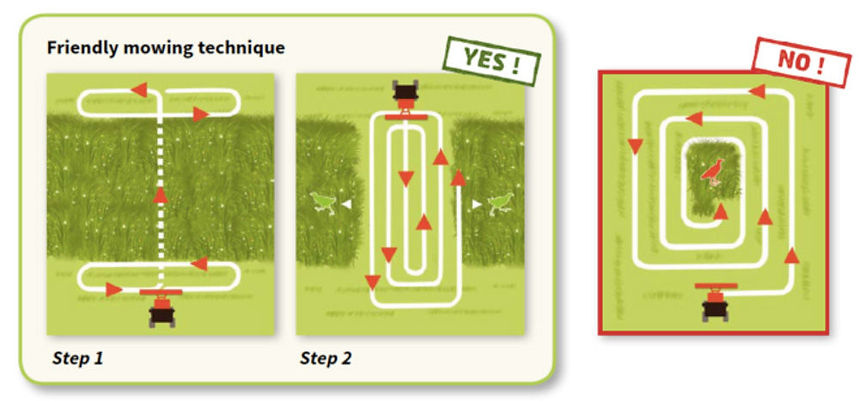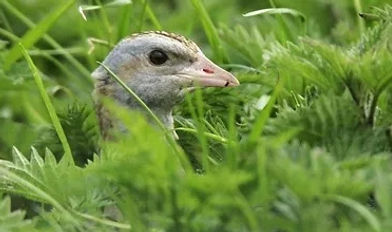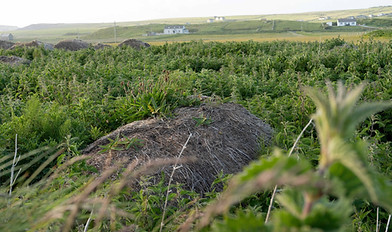
Landscape Actions
Landscape Actions (LAs) are large scale environmental actions that will focus on issues such as invasive species management, controlling encroaching scrub on species rich grassland, supporting priority species/habitats and water quality protection. These types of actions are generally beyond the scope for individual farmers to address but have many benefits for the community and the environment at large.
Some of the key Landscape Actions for the Acres Burren Aran region are listed below. For a full list of all LAs, click here.

Invasive Species
Invasive Species Training
Where ACRES participants plan to carry out the invasive species management themselves, rather than through a contractor, they will be required to first fully complete a paid, three-hour training course.

Invasive Species Management
To treat and help prevent the spread of invasive species by targeted application of herbicide. Invasives species of particular concern in the Burren-Aran CP region include Japanese Knotweed, Rhododendron, Gunnera and Himalayan Balsam. A particular focus for us will be the targeting of Japanese Knotweed in the Aille river catchment.
Japanese Knotweed spreading extensively across farmland (Credit: Inishown Rivers Trust)
Winterage Management
Traditional Dry Stone Wall (Full Rebuild)
To rebuild sections of freestanding dry-stone walls where they have fallen fully into disrepair. This action may also be used to build new stone walls in areas where sufficient stone is available.

Machine Scrub Removal: Area / Liner
The removal of encroaching scrub, typically Hazel, Briars and Blackthorn can greatly benefit biodiverse winterage grassland fields. Through this LA the removal of scrub using a machine-mounted flail (cutting) or pulling with a grab on deeper soil may be possible on suitable sites. This action will almost exclusively be used on winterage fields or areas of very high species-richness and it will not be used to reclaim scrub for productive grasslands.

Water Retention Structure in Karst Landscapes (Spring Catcher)
This LA proposes to retain water in karst landscapes by building a shallow concrete structure that holds water as it flows from a natural spring. A well built spring catcher prevents direct cattle access (where applicable) through the use of metal barriers. The catcher could also be create a head of water to supply water troughs and/or water storage tanks.

Wildlife and Habitat Support
Wildlife Pond (With or without liner)
This LA proposes to improve on farm biodiversity by providing habitat for a range of wildlife by constructing a wildlife pond. Healthy ponds can support a vast array of aquatic plants, insects and other wildlife. Ponds can also help to retain water on the land, releasing it slowly back into the soil in times of drought. This action also includes funding for a liner if being installed in a free draining area.

Construction of Lesser Horseshoe Bat Roosts
These summer roosts can be built by the patricipant and located in areas which would benefit foraging Lesser Horseshoe Bats to roost overnight. The overall aim of the action is to reconnect isolated populations of Lesser Horseshoe Bat by installing roost boxes at strategic locations between isolated populations.

Night Roost (Vincent Wildlife Trust)
Rural Restorative Lighting
Farmyards can be sources of light pollution which has knock-on impacts on nocturnal wildlife, this action provides a payment to the participant for changing bright outdoor light fixtures on farms to dark-sky friendly (dimmer, warmer) light fixtures to reduce impact on nocturnal animals in rural areas. Dimmer light fittings have been shown to increase security by reducing glare. This action pairs well with the Lesser Horseshoe Bat roost by improving habitat condition during the bats’ most active hours.

Credit: Dark Sky Ireland
Virtual Fencing
To increase farmers capacity to manage grazing on upland sites and priority habitats. This new virtual fencing technology has huge potential for aiding conservation objectives and for helping farmers to get more forage out of remote sites. Virtual Collars are currently being trialed by participants of the ReFarm project in the Burren.

Rare Birdlife Support
Geese and Swans on Grassland
To provide suitable habitat and forage for overwintering Geese and Swans by retaining fields with sufficient grass cover over the winter period. Parcels must be closed off from livestock and machinery from 1st of October to the 31st of March in the year following approval. Birds must not be disturbed during periods of occupancy.
Wildlife Friendly Mowing
Wildlife friendly mowing is a mowing technique which can improve the survival of ground nesting birds and other wildlife in mown fields. When mowing, the machine operator maintains a low mowing speed, mowing from the centre of the field outwards slowly pushing birds out to the edges of the field into cover.

Credit: Mowing Examples (Corncrake LIFE)
Breeding Wader Delayed Mowing
Delay in-field machinery activity until after the main breeding perod (15th March - 15th August). The aim is to minimise potential injury to ground-nesting birds and chicks when managing grass.

Corncrake Delayed Mowing and Grazing
To provide cover and nesting shelter by delaying all grazing and mowing in potential Corncrake nesting areas between April 1st and August 15th.

Corncrake Early and Late Cover (Crop)
Early/Late Cover (ELC) Crop is aimed at establishing and managing a cover for Corncrake in early spring and late in the season to provide shelter, concealment, prey and nest sites. CP team will provide specific information on crop seeding rates and seed mix in a site-specific plan.

Corncrake Early and Late Cover (Natural)
Early/Late Cover (ELC) Natural is aimed at establishing and managing natural cover for Corncrake in early spring and late in the season to provide shelter, concealment, prey and nest sites. This is achieved by cultivating an area of 0.1 Ha (1000m2), applying manure/rotten bales and establishing at least one of the following plants to provide tall vegetation: Nettles, Cow Parsley, Common Hogweed or Yellow Flag Iris.

Water Quality Protection
Livestock Crossing Point
This LA proposes protecting watercourses and drains from bank erosion and sediment/nutrient loss by installing a single footbridge using heavy duty precast concrete slabs to facilitate crossing livestock.

In-Ditch Wetland
This LA proposes to slow the flow of drains discharging to natural watercourses by using a track machine to re-profile ditches to create areas where wetland vegetation can develop. This vegetation slows water flows, increases sediment deposition, and helps remove nutrients from the water. These wetlands may also develop into valuable wildlife habitats in their own right.
Drain Blocking Peat/Timber Dam
This LA proposes raising the water table within degraded peatlands to facilitate Sphagnum growth and revegetation of bare peat by plugging drains with peat with the use of a track machine, or through the creation of timber dams. This is one of the most important actions available for helping to raise peatland scores where drainage is a key issue.

Track Drainage
This LA proposes to improve the condition of existing tracks by installing cross drains to manage on-track water flow and to divert water into track-side sediment capture ponds with the aim of reducing track scouring, erosion and sediment loss into drains and watercourses.

Ditch/Peat Reprofiling
This LA proposes widening the slopes of deep narrow drains/channels using a track machine to provide suitable habitat for breeding waders and to encourage the development of aquatic vegetation. It can also be used to reprofile the steep edges of peat banks in areas of peat erosion or old cut-over bog sites.






